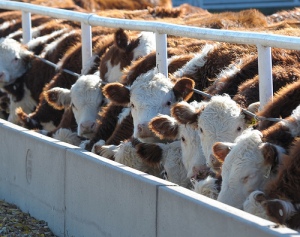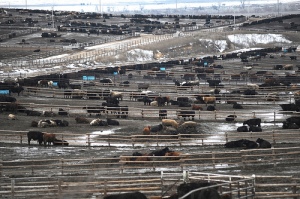Industry Offers New Tool for BVD Management
Article Courtesy of Micky Burch, Nebraska Cattlemen
 Many of us have heard the saying, “Don’t judge a book by its cover.” That lesson can be taken to heart when managing your cow herd for bovine viral diarrhea (BVD). BVD is a transitional disease, which means you can’t tell by looking if an animal has the virus. Years of research has helped identify the disease as having significant effects on productivity, especially reproductive and respiratory health, and now a new tool – BVD CONSULT (Collaborative Online Novel Science-based User-friendly Learning Tool) – has been introduced to the industry to help manage the virus at the cow-calf level.
Many of us have heard the saying, “Don’t judge a book by its cover.” That lesson can be taken to heart when managing your cow herd for bovine viral diarrhea (BVD). BVD is a transitional disease, which means you can’t tell by looking if an animal has the virus. Years of research has helped identify the disease as having significant effects on productivity, especially reproductive and respiratory health, and now a new tool – BVD CONSULT (Collaborative Online Novel Science-based User-friendly Learning Tool) – has been introduced to the industry to help manage the virus at the cow-calf level.
BVD Background
In his article “Use of a BVD Management Tool: BVD CONSULT,” Bob Larson, DVM, Ph.D., Kansas State University, explains that the virus is costly to cattle producers, because it causes immune suppression, respiratory disease, infertility and fetal infection.
One of the most detrimental effects of BVD takes place between (approximately) Day 45 and Day 135 of gestation – when the fetus hasn’t fully developed an immune system. If a fetus contracts the virus from its dam during this window of time, it becomes persistently infected (PI) with the BVD virus. Shortly after this time frame and up to about Day 160 of gestation, if the fetus contracts the BVD virus, congenital defects can result. “There can be skeletal, eye or brain defects or stillbirths may occur,” explains Dale Grotelueschen, DVM, MS, University of Nebraska Great Plains Veterinary Educational Center. “Cerebellar hypoplasia is an example of a brain defect resulting from a fetal BVD virus infection where the calf may be born alive, but is unable to rise and is uncoordinated.” Most calves that contract BVD in utero get it when their dams are exposed to and are undergoing acute infections of BVD, often following nose-to-nose contact with another animal that has the disease.
PI calves can also seem perfectly healthy, and healthy-appearing replacement females that are PI may enter your herd. In this instance, a PI dam will always give birth to a PI calf. PI cattle carry the disease their entire lives and shed the virus from every orifice of their body, especially through nasal discharge, saliva and feces. “Preventing the birth of PI calves is a major focus for control in herds and in the cattle industry,” Grotelueschen explains. He also says that an extensive study found herds with PI calves had five percent lower pregnancy rates than herds without infected calves.
Because you can’t tell by looking, PI BVD cattle must be identified through lab tests. According to the National Animal Health Monitoring System’s (NAHM’s) 2007-2008 beef cow-calf study, 8.8 percent of U.S. cow-calf ranches identified one or more PI animals, meaning that one in every 11 to 12 herds have PI calves, and most are not aware of their presence.
In recent years, Larson adds, the cattle industry has made huge strides understanding BVD. “Our current knowledge of BVD, the availability of effective vaccines, and the improvement in diagnostic tools have made the control of BVD feasible,” he says. The key to using these resources, Grotelueschen continues, is to design individualized herd-control plans for the disease. That’s where BVD CONSULT comes in.
BVD Consult
BVD CONSULT is an internet-based tool for developing herd health plans for cattle operations; this means the producer makes choices and then sets goals for how BVD control can be accomplished in their herd. BVD CONSULT was designed for producers to work with their herd veterinarians to develop BVD control and prevention plans. For herds that currently have PI cattle present, the tool helps create a plan to identify and remove those cattle and establish a strategy to reduce the likelihood of the herd becoming infected again, Larson explains. For herds that are currently virus-free, BVD CONSULT can be used to decide how to minimize the likelihood of the disease entering the herd and to reduce the impact if the herd is exposed.
“Using BVD CONSULT is simple,” Larson continues in his article. “The system is set up online as a series of questions with responses designed to mimic a conversation between a veterinarian and a producer who is concerned about BVD.” The program then provides recommendations specific to individual operations. After clicking “yes” or “no” to answer each question, an appropriate response is given based on the choices that have been made, followed by another question. The questions that are asked, and the responses given, vary depending on the previous answers. There are six to 10 questions depending on the choices made. A printable report is available at the end of the questionnaire, which records the choices that were made and responses given.
Sample questions from the BVD CONSULT questionnaire include:
- Do you have active BVD in your herd?
- Will you institute a testing strategy that identifies all PI BVD cattle and remove them from your herd?
- Will you quarantine and test all new cattle coming into your breeding herd?
- Can you prevent fence line and direct contact of your pregnant herd with other cattle?
Jeremy Van Boeing, DVM, Republican Valley Animal Center, Alma, Neb., and chairman of NC’s Animal Health committee, has already started helping his clients utilize BVD CONSULT in their herds. “This program simplifies decision making for producers when it comes to BVD management,” he explains. “It’s a tool that allows producers to look at the disease on their own time, then discuss the questions they have with their veterinarian so they know what the next step is and how to take it.”
All-in-all, Grotelueschen says, BVD CONSULT is an opportunity to increase the level of herd health plans in a way producers are comfortable with. More information and the online questionnaire can be found by visiting www.bvdinfo.org.
Reprinted with permission from September 2013 Nebraska Cattleman magazine.







